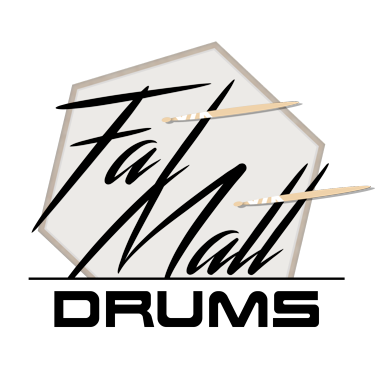Ghost Meat has the bones of an accent tap exercise, but the muscle of a doublestroke exercise and the skin of a singlestrokes exercise. The name was inspired by the notion of “ghost notes” which are the subtle inner beats that add character and direction to an overarching rhythmic figure… it’s always crucial that ghost notes be sweet and low. This warm-up employs solid, monotone slurred ruffs (“pudidahs”) in both ninelet and sextuplet contexts before adding some accents to create true “ghost note” contexts. The bottom half of the piece shifts from the accent-tap focus to a singlestroke rolls focus, and it will require considerable maturity to accurately shift between the ninelet, sixteenth-note, and sextuplet rhythms of the singlestrokes.
Groovy Grandmas
Groovy Grandmas (2021) is a paradiddles warm-up that really is all about the paradiddles. The long series of monotone taps with paradiddle sticking should really get you focused on consistency and quickness of wrist turn at the low dynamic. The accents that create the grooves, then, must rise out of the monolithic sound created by the ensemble being locked in completely to the taps.
Syncoparadiddles
Syncoparadiddles (2021) is a paradiddles warm-up that employs a repeating syncopated motif to cast paradiddles in various revealing situations to help you better apply great fundamentals to paradiddles. The beginning is all about understanding the application of rebound and maximising the efficient use of rebound while also playing aggressively into the drum. Measures 5–8 are all about consistently even taps before the accents are added in the latter half of the exercise.
Vorticity
Vorticity (2021) (∇ x v) is an ensemble chop-out exercise that hits lots of big legatos, some doublestrokes, some rolls (and even some flam accents, snares!), and some more big legatos, so your line can jam out, get a work out, and stretch out, all in one warm-up. This piece would be suitable for a committed high school or university drumline, and I think the vibe, the vocabulary, and the vivacity of the music would make this a hit in any parking lot or pre-show warm-up.
The title is an obvious nod to the Bluecoats warm-up that inspired the person who asked me to write something like this to ask me to write something like this.
Chow Down
Chow Down (2021) is an all-around and all-in-one ensemble warm-up targeting the high school level. It consists of five “movements”: 1. Legatos, 2. Bucks, 3. Doubles I, 4. Doubles II, and 5. Triplet Rolls. Each movement could be used as a standalone warm-up, and you can gradually work each movement into the full sequence as the season progresses, so that you have both a warm-up book, and a cohesive ensemble warm-up, however you are able to deploy it. It may be beneficial for the snares to learn the tenor part in some places, as some passages involve the snares playing a fundamental exercise pattern while the tenors play an even more fundamental breakdown of the motion involved in that pattern.
This warm-up was originally conceived for tri-toms instead of quad or quint tenors, so that is the arrangement you will hear in the Virtual DrumLine (VDL) recording. I am providing the score to both arrangements here:
Kicked in the Grace
Kicked in the Grace (2007) is a four-measure flam étude that employs a myriad of grace-note contexts: flam-accents, flam-taps, swiss triplets, inverted flam-taps, etc. The scope is broadened by adding drags to produce different variations.
In a line setting, the variations can be chained together as appropriate. Additionally, the snare and quad parts, by ending on an eighth note upbeat, allow "off the left" variations to be seamlessly added to the sequence.
Dub/Huk
I inflicted Dub/Huk (2010) on the Athens Drive HS Drumline in order to help work on doublestrokes: specifically, second note quality in doublestroke rolls, and sixteenth-note consistency (timing and quality) for paradiddle figures.
The first half of the piece builds the doublestroke roll and inverted roll from their one-handed breakdowns. I like working on inverted rolls because the second note of the doublestroke is placed on the eighth note partials, rather than sixteenth-note upbeat partials; i.e. deficiencies in timing and quality of those notes will be more obvious to the ear and mind, allowing these deficiencies to be corrected.
The second half works on a syncopated hucka-dig (one-handed breakdown of a paradiddle-diddle) pattern and then fills it in to the corresponding paradiddle figure. Ensemble timing is tricky for this part; accents on the fourth sixteenth note partial will tend to be late, while those on the upbeat eighth notes will tend to be early. This warm-up is a huge bag of mess without dedicated practice with a metronome.
The bass drum part is such that all the written notes could be played as a single unison part.
Blat
Blat (2010) combines triplestrokes with hugadigs (one-handed breakdown of a flam-tap) and flam rudiments. The more thinly-written middle part centres around what's called the "Cary lick" in the quad line, with a flam accent breakdown in the snare line.
The way the heights are notated, there is a slight difference between the threes of the triplestroke bars, and those of the flam-tap bars, though not every instructor/line makes such a distinction. I think of triplestrokes as being allowed a bit more freedom to rebound, while hugadigs are controlled a bit more to achieve a lower height on the third note (the grace note of the flam-tap).
Paradiddle Flow
Paradiddle Flow (2009) is a simple warm-up that emphasizes 16th-note timing consistency within different stickings (puh-duh-duh, paradiddle, paradiddle-diddle, slurred six-stroke roll). Practice at a single height (i.e. all taps) will build comfort with the different stickings. Practice at different accent heights will build comfort with the downstrokes involved.
The bass drum part is such that all the written notes could be played as a single unison part.
Flams '09
Flams '09 (2009) was the flams warmup of the 2009 NC State Drumline. It covers flam accents, flam-taps, and (for the snares) inverted flam taps. There are some flam drags at the end too, so good luck with those. I think this is a good piece for a university drumline, since the upper battery works on the main flam demands that a college line should expect to encounter, while the bass line gets a bit more work on doublestrokes. The snares are required to play inverted flam taps, while the quads work on the upstroke motion in the context of the skank/mute patterns that are often encountered in street beats and stadium grooves.
If I were to use this piece today, I would change the first two bars to be double-stops in the snare and quad parts, since that forces performers to work on the quadruple-stroke that shows up in the written flam pattern.
High Five (Paradiddles)
High Five (2009) is an all-around doublestroke étude; double-beats, paradiddles, and rolls (slurred and straight) must be mastered in order to pull this one off. This piece is based on an onfield warm-up I wrote with the same name.
The way it is constructed, isolatation and repetition of individual measures will be a useful practice tool in putting together this warm-up. This piece was first performed by the 2009 NC State Drumline.
This one also has double paradiddles, so don't misread the stickings... I know people don't write those too often anymore.
The bass drum part is such that all the written notes could be played as a unison part.
Matt A-B
Matt A-B (2010) is a variation on the A/B/C Sanford-type double beat exercise, arranged for full battery. I used this with the 2009-2010 Athens Drive HS Indoor Drumline to cover the demands of a stick control exercise, a paradiddle exercise, and a double-beat exercise, all in one piece that was constructed piecemeal from other parts of their audition packet (e.g., 8-on-a-hand bass splits). It turned out really well for its simplicity.
Accent Tap
Accent Tap (2008) is a comprehensive two-height warm-up that covers buck figures, accent-tap contexts, singlestroke figures, and paradiddle figures. It was written with the goal of being part of the NCSU Drumline warm-up repertoire, but John wrote an on-field warm-up with more brevity and focus. This, however, is a good long warm-up to work on accents and taps, with some groovy interludes. It's based on Groovement Movement from the original FatMattDrums, and I think that any level of drumline could find some useful portions to excerpt from it.
Swingerbeat
Swingerbeat (2008) highlights three different contexts for doublestrokes: the second note rebounding to re-attack at the same height as the first stroke, the second note being downstroked to re-attack at the tap height, and the second note being upstroked to re-attack at the accent height.
While there really isn't any emphasis on paradiddle figures, the hucka-dig motion is employed heavily.
The last bar of the piece is very much like the tap-off. In a line setting, it would probably work to just repeat the warm-up as if the last bar is the tap off (i.e. add the pickup from the last 24th-note of bar 1 to the final bar, and resume at bar 2).
Bread & Butter: Dubs
Bread and Butter: Dubs (2007) is a stock-type double beat exercise that would be well-suited to a high school drumline that is ready to do their homework. Take it slow (slower than the 112 BPM marked… try 80 BPM!) to work on the rhythms, and hey, it turns out that working on doubles that slowly is also very beneficial! It comes from the Bread and Butter packet from the original FatMattDrums website, and I think it has aged well enough to deserve new life here.
Edit 14 November 2021: The link to the pdf was broken, and I have fixed it.
Bread & Butter: Paradiddles
Bread & Butter: Paradiddles (2007) was part of the Bread and Butter warm-up packet from the old FatMattDrums, and I think it has aged well enough to deserve new life here. It begins with a simple paradiddle builder then works its way into some mixed-meter patterns with various degrees of grooviness. Mark time or don't... or just halt when things get tricky. Either way, this one should be a lot of fun!
Diddle Me Timbers
Diddle Me Timbers (2007) is a paradiddles warm-up with a little more variety than Paradiddle Flow. The double paradiddle rudiment makes an appearance here as well, so don't misread them as paradiddle-diddles.
The bass drum part is such that all the notes with stickings could be played as a single unison part, leaving the notes without written stickings as a split. The bass line is then challenged as much as the snares or quads to perform paradiddle-related rudimental demands.


















